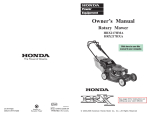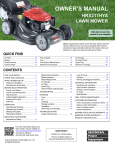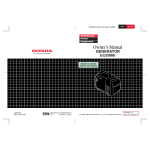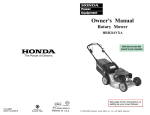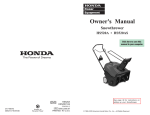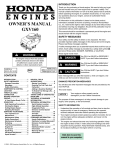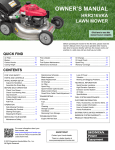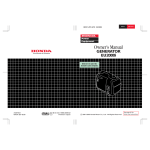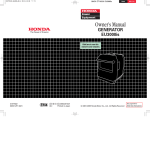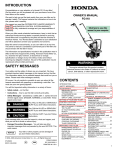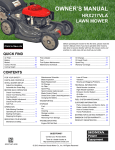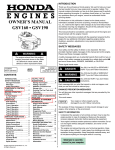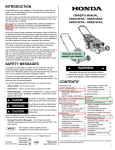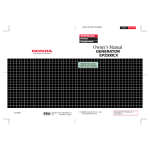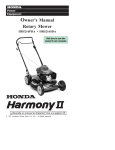Download Honda HRX217HMA User's Manual
Transcript
INTRODUCTION Congratulations on your selection of a Honda lawn mower! We are certain you will be pleased with your purchase of one of the finest lawn mowers on the market. OWNER’S MANUAL HRX217HMA HRX217HXA We want to help you get the best results from your new mower and to operate it safely. This manual contains the information on how to do that; please read it carefully. We suggest you read the Distributor’s Limited Warranty (page 19) and Emission Control System Warranty (page 21) to fully understand coverage and your responsibilities of ownership. When your mower needs scheduled maintenance, keep in mind that an authorized Honda servicing dealer is specially trained in servicing Honda mowers and is supported by the parts and service divisions of American Honda. Your Honda dealer is dedicated to your satisfaction and will be pleased to answer your questions and concerns. Keep this owner’s manual handy so you can refer to it at any time. This owner’s manual is considered a permanent part of the lawn mower and should remain with the lawn mower if resold. The information and specifications included in this publication were in effect at the time of approval for printing. American Honda Motor Co., Inc. reserves the right, however, to discontinue or change specifications or design at any time without notice and without incurring any obligation whatever. No part of this publication may be reproduced without written permission. SAFETY MESSAGES Your safety and the safety of others are very important. We have provided important safety messages in this manual and on the mower. This information alerts you to potential hazards that could hurt you or others. Please read these messages carefully. Of course, it is not practical or possible to warn you about all the hazards associated with operating or maintaining a lawn mower. You must use your own good judgment. You will find important safety information in a variety of forms: • Safety Labels – on the lawn mower. • Instructions – how to use this mower correctly and safely. • Safety Messages – preceded by a safety alert symbol and one of three signal words: DANGER, WARNING, or CAUTION. These signal words mean: DANGER You WILL be KILLED or SERIOUSLY HURT if you don't follow instructions. WARNING You CAN be KILLED or SERIOUSLY HURT if you don't follow instructions. CAUTION You CAN be HURT if you don't follow instructions. Each message tells you what the hazard is, what can happen, and what you can do to avoid or reduce injury. • Damage Prevention Messages – You will also see other important messages that are preceded by the word NOTICE. This word means: NOTICE Your engine or other property can be damaged if you don’t follow instructions. © 2003-2006 American Honda Motor Co., Inc.—All Rights Reserved 31VH7H30 00X31-VH7-H300 EM5 K1 WARNING: The engine exhaust from this product contains IPC chemicals known to the State of California to cause cancer, birth defects or other reproductive harm. CONTENTS* INTRODUCTION...................................... 1 SAFETY MESSAGES .............................. 1 LAWN MOWER SAFETY......................... 2 IMPORTANT MESSAGE TO PARENTS......................................... 2 SAFETY LABEL LOCATIONS.......... 2 SETTING UP YOUR NEW MOWER........ 3 CONTROL LOCATIONS.......................... 4 BEFORE OPERATION ............................ 4 IS YOUR LAWN MOWER READY TO GO? ............................................ 4 CHECK YOUR MOWING AREA ...... 4 GET THE MOWER READY.............. 5 OPERATION ............................................ 6 MOWING PRECAUTIONS ............... 6 STARTING THE ENGINE................. 6 OPERATING THE CONTROLS FOR MOWING.................................. 7 STOPPING THE ENGINE ................ 8 SAFE MOWING PRACTICES .......... 8 SERVICING YOUR LAWN MOWER ....... 9 MAINTENANCE SAFETY................. 9 MAINTENANCE SCHEDULE ........... 9 BLADES.......................................... 10 GRASS BAG CLEANING AND REPLACEMENT............................. 11 ENGINE MAINTENANCE............... 11 REFUELING ................................... 12 CHARGING THE BATTERY (HRX217HMA ONLY) ..................... 13 REPLACING THE FUSE (HRX217HMA ONLY) ..................... 14 TRANSPORTING...................................14 STORAGE..............................................14 TAKING CARE OF UNEXPECTED PROBLEMS ...........................................16 TECHNICAL INFORMATION.................16 SERIAL NUMBER LOCATIONS.....16 CARBURETOR MODIFICATION FOR HIGH ALTITUDE OPERATION ................17 EMISSION CONTROL SYSTEM ....17 AIR INDEX ......................................18 SPECIFICATIONS ..........................18 CONSUMER INFORMATION ................19 REPLACEMENT PARTS, OPTIONAL EQUIPMENT, AND SERVICE ITEMS ............................ 19 DEALER LOCATION INFORMATION...............................19 CUSTOMER SERVICE INFORMATION...............................19 DISTRIBUTOR'S LIMITED WARRANTY ...................................19 ACCESSORIES, REPLACEMENT PARTS, AND APPAREL WARRANTY ...................................20 EMISSION CONTROL SYSTEM WARRANTY ...................................21 * For information regarding cable adjustment, spark arrester service, and how to mow your lawn, see FAQs at www.hondapowerequipment.com. POM53618-D IPC 11300.2006.12 PRINTED IN U.S.A. 1 LAWN MOWER SAFETY Most accidents with walk-behind mowers can be prevented if you follow all instructions in this manual and on the mower. The most common hazards, according to accident statistics, are discussed below, along with the best way to protect yourself and others. Avoid Rotating Blades Rotating blades can cause serious cuts and even amputate fingers, hands, toes, or feet. Keep away from the mower deck whenever the engine is running. If you need to adjust the cutting height or work around the deck for any other reason, always shut off the engine. Wear heavy gloves and disconnect the spark plug cap when you need to clean the mower deck or handle the blades. Clear Mowing Area Mower blades can throw rocks and other objects with enough force to cause serious injury. Before mowing, carefully inspect the area and remove all sticks, stones, pieces of wire, and other loose objects. Never operate the blades over gravel. Keep Shields in Place Guards and shields are designed to protect you from being hit by thrown objects and from hot engine parts and moving components. For your safety and the safety of others, keep all shields in place when the engine is running. Refuel with Care Gasoline is extremely flammable and gasoline vapor can explode. Refuel only outdoors in a well-ventilated area with the engine OFF. Never smoke near gasoline and keep other flames and sparks away. Always store gasoline in an approved container. Wear Protective Clothing Wearing protective clothing will reduce your risk of injury. Long pants and eye protection reduce the risk of injuries from thrown objects. Sturdy shoes with aggressive soles will help protect your feet and give you better traction on slopes or uneven ground. Turn Engine Off When Not Mowing If you need to leave the mower for any reason, even just to inspect the lawn ahead, always turn the engine OFF. IMPORTANT MESSAGE TO PARENTS YOUR CHILDREN’S SAFETY IS VERY IMPORTANT to Honda. That’s why we urge you to read this message before letting your child operate this lawn mower. Lawn mowers are tools, not toys. As with any equipment, bad judgments can result in serious injuries. You can help prevent accidents by making good decisions about if, when, and how your child operates this equipment. The first question you’ll need to ask is whether your child is capable of operating this mower safely. Remember, young people vary widely, and AGE IS NOT THE ONLY FACTOR. Physically, a child must be LARGE ENOUGH AND STRONG ENOUGH to easily start the mower and control its direction. The child also needs enough size, strength, and coordination to comfortably reach and operate the controls. A tougher question you need to ask is if your child has enough MATURITY AND RESPONSIBILITY to safely operate this mower. Does the young person think through problems and come to logical solutions? Be honest! Anyone who takes unnecessary risks and doesn’t obey rules should not operate this lawn mower. 2 If you decide that your son or daughter can handle the mower safely, CAREFULLY READ THE OWNER’S MANUAL with your child. Make sure you both understand all instructions and safety information. Also, be sure your child wears sturdy shoes and other protective clothing when operating or handling the mower. SUPERVISION is also very important. Walk with your child during the first few minutes of mowing. Even after he or she has become confident with the mower, do not let him or her use the mower without good adult supervision. An adult should also be present during refueling and maintenance. In fact, it’s up to the adult owner to make sure that the mower is properly maintained and kept in safe operating condition. By always placing safety first, your child will acquire useful skills and a sense of accomplishment. And you’ll both get the best results from your lawn mower. SAFETY LABEL LOCATIONS These labels warn you of potential hazards that can cause serious injury. Read them carefully. If a label comes off or becomes hard to read, contact an authorized Honda servicing dealer for a replacement. SETTING UP YOUR NEW MOWER Engine Oil Unpacking A bottle of oil is included in the box with your mower. Add the entire contents of the oil bottle into the oil filler opening. The mower is shipped WITHOUT OIL in the engine. Remove all the cardboard from around the handlebar. Handlebar Setup 1. With the handlebar adjust knobs in the unlocked position, raise the handlebar into the mowing position. HANDLEBAR ADJUST KNOB (2) LOCKED 2. Align the adjust knobs with one of the three holes on the handle stay. UNLOCKED Setting the adjust knobs in the lowest holes raises the handlebar to its highest position, and setting the adjust knobs in the highest holes lowers the handlebar to its lowest position. 3. Turn the adjusting knobs 90 degrees into the lock position and the pins will spring into the holes and lock into position. Battery (HRX217HMA only) The mower is shipped with the battery disconnected. The battery is shipped with a partial charge and should be charged for 20 to 24 hours before use. Refer to “CHARGING THE BATTERY (HRX217HMA ONLY)” on page 13. All Honda engines are run at the factory prior to packaging. Most of the oil is removed prior to shipment; however, some oil remains in the engine. The amount of oil left in the engine varies. If not using the supplied oil, add enough SAE 10W-30 API service category SJ or later oil to bring the oil level between the upper and lower limit marks on the dipstick as shown. FILLER CAP/DIPSTICK (DO NOT SCREW IN THE DIPSTICK WHEN CHECKING THE OIL LEVEL.) Do not overfill the engine with oil. If the engine is overfilled, the excess oil may get transferred to the air cleaner housing and air filter. UPPER LIMIT LOWER LIMIT After filling the engine with oil, remove the hang tag near the recoil starter grip that says “The engine has no oil. A container of oil is in the shipping box.” Install the key in the switch. Grass Bag Assembly Slide the grass bag frame into the grass bag and install the clips as shown. GRASS BAG Fuel Refer to page 12. Before Operation Before using the lawn mower, all mower operators must read the following sections: • LAWN MOWER SAFETY (page 2) • CONTROL LOCATIONS (page 4) BAG FRAME • BEFORE OPERATION (page 4) BAG FRAME • OPERATION (page 6) PLASTIC CLIP • MAINTENANCE SCHEDULE (page 9) You can also find additional information on the Honda power equipment web site. Visit www.hondapowerequipment.com/faq.htm. Lift the discharge guard and install the grass bag. 3 CONTROL LOCATIONS BEFORE OPERATION Your safety is your responsibility. A little time spent in preparation will significantly reduce your risk of injury. HANDLEBAR (P. 3) Read and understand this manual. Know what the controls do and how to operate them. SHIFT LEVER (P. 7) THROTTLE LEVER (P. 7) Familiarize yourself with the lawn mower and its operation before you begin using it. Know how to shut off the lawn mower quickly in case of an emergency. DISCHARGE GUARD (P. 5) IS YOUR LAWN MOWER READY TO GO? FUEL TANK CAP (P. 12) KEY SWITCH (HMA ONLY) (P. 7) For your safety, and to maximize the service life of your lawn mower, it is very important to take a few moments before you operate the lawn mower to check its condition. Be sure to take care of any problem you find or have your servicing dealer correct it before you operate the lawn mower. WARNING GRASS BAG (P. 6) Improperly maintaining this lawn mower or failing to correct a problem before operation could cause a malfunction in which you could be seriously injured. OIL FILLER CAP (P. 3) CUTTING HEIGHT ADJUSTMENT LEVER (4) (P. 6) Always perform a pre-operation inspection before each operation and correct any problem. MUFFLER Before beginning your pre-operation checks, be sure the lawn mower is on a level surface. Check the General Condition of the Lawn Mower BLADE CONTROL LEVER (P. 7) • Look around and underneath the lawn mower for signs of oil or gasoline leaks. • Look for signs of damage. • Check each control for proper operation. BATTERY (HMA ONLY) (P. 13) • Check the blades for wear. Replace as necessary (page 10). • Check that the blade bolts are tight (page 10). • Check that all nuts, bolts, and screws are tightened. RECOIL STARTER GRIP (P. 6) Check the Engine • Check the air cleaner (page 12) and oil level (page 11). DRIVE CLUTCH LEVER (P. 7) SPARK PLUG CAP (P. 12) • Check the fuel level (page 12). Starting with a full tank will help eliminate or reduce operating interruptions for refueling. CHECK YOUR MOWING AREA HANDLEBAR ADJUST KNOB (2) (P. 3) CARBURETOR CLIP DIRECTOR® KNOB (P. 5) For your safety and the safety of others, always inspect the area before operating the lawn mower. Objects Anything that can be picked up by the blades and thrown is a potential hazard to you and others. Look for things like stones, sticks, nails, and wire, and remove them from the work area. FUEL VALVE (P. 6) People and Pets CUTTING HEIGHT ADJUSTMENT LEVER (4) (P. 6) AIR CLEANER (P. 12) People and animals near the work area can move into your lawn mower’s path or into a position where they could be struck by thrown objects. Clear the area of pets and people, especially children. Their safety is your responsibility. Work Area Check the condition of the grass. Adjust your lawn mower ground speed and mowing swath accordingly. 4 GET THE MOWER READY Sliding Door Position Handlebar Height Adjustment Adjust handlebar height for a comfortable operating position (page 3). Clip Director® Adjust the Clip Director knob in any one of the ten positions to achieve the desired mowing results. To adjust the Clip Director knob, pull the knob downward and towards the rear of the mower. The knob adjusts a sliding door from the fully open BAG position to the fully closed MULCH position. The sliding door can be positioned to produce different mowing results. If the preferred sliding door position is unknown, install a grass bag and begin mowing with the Clip Director knob all the way to the BAG position. Check the appearance of the lawn. As the knob is moved towards the MULCH position, more grass will be recycled back into the lawn. Adjust the Clip Director knob until the desired result is achieved. CLIP DIRECTOR KNOB BAGGING OR REAR DISCHARGE AND SOME MULCHING CLIP DIRECTOR KNOB SLIDING DOOR (50% open) SLIDING DOOR (FULLY CLOSED) DISCHARGE GUARD IMPORTANT SAFETY PRECAUTION FULL BAGGING OR REAR DISCHARGE FULL MULCHING KNOB (BAG POSITION) KNOB (MULCH POSITION) Always turn the engine off, remove the key (HRX217HMA only), and disconnect the spark plug cap (page 12) before lifting the discharge guard to view or clean around the sliding door. This will prevent contact with the rotating blades and prevent objects from being thrown into the discharge area. Some grass accumulation in the discharge opening is normal when the Clip Director is fully closed. To remove this grass, close the discharge guard, fully open the Clip Director, start the engine, and engage the blade control lever several times. If a high resistance is noticed when moving the Clip Director knob from side-to-side, excessive grass may have built up on top of the sliding door. SLIDING DOOR (fully open) SLIDING DOOR (fully closed) Rear Discharge To discharge clippings to the rear, remove the grass bag and position the Clip Director knob in the BAG range. Maximum rear discharge will occur when the Clip Director knob is all the way to the left (BAG) position. As the Clip Director knob is moved toward the right (MULCH) position, less grass will be discharged through the rear discharge guard. Fallen Leaves Use the Clip Director to shred and collect fallen leaves for disposal. Set the front wheels so they are one or two settings higher than the rear. Set the Clip Director in position #9 (not quite full mulching) and adjust the setting from this point for best results. 5 Grass Bag A lawn mower works like a vacuum cleaner; it blows air through the bag, which traps the grass clippings. Always empty the grass bag before it becomes filled to the limit of its capacity. Bagging performance will diminish after the bag becomes about 90% filled. Also, the bag is easier to empty when it is not packed full. The grass bag can be left on the mower during mowing, then depending on conditions, certain areas may require full mulching where as other areas may require bagging. By adjusting the Clip Director knob, various mowing conditions can be met. Inspection During normal use, the grass bag material is subject to deterioration and wear. NOTICE Frequently inspect the grass bag for tears, holes, and excessive wear. Check for necessary replacement. Make sure the new bag meets the original specifications. Grass bag replacement is explained on page 11. Installation 1. Raise the discharge guard and hook the grass bag onto the mower deck as shown. OPERATION MOWING PRECAUTIONS Before operating the mower for the first time, please review LAWN MOWER SAFETY (page 2). Even if you have operated other mowers, take time to become familiar with how this mower works and practice in a safe area until you build up your skills. For your safety, avoid starting or operating the engine in an enclosed area, such as a garage. Your mower’s exhaust contains poisonous carbon monoxide gas, which can collect rapidly in an enclosed area and cause illness or death. STARTING THE ENGINE Before starting, always release the drive clutch lever, so the mower will not move forward when you operate the starter. 1. Turn the fuel valve to the ON position. DISCHARGE GUARD GRASS BAG HANDLE ON BAG 2. Release the discharge guard to secure the grass bag. 2. Move the throttle lever to the proper starting position. Removal COLD ENGINE: 1. Raise the discharge guard, grasp the grass bag handle, and remove the grass bag. Move the throttle lever to the CHOKE position. 2. Release the discharge guard. Move the throttle lever to the FAST position. WARM ENGINE: FAST 3. When the grass bag is clear of the discharge guard, you can lift it through the handlebar opening, or you can remove it to the rear of the mower below the handlebar. Cutting Height Adjustment ADJUSTMENT LEVERS Each wheel of the mower can be adjusted to one of seven settings. The cutting height figures are approximate. The actual height of cut grass will vary with lawn and soil conditions. Move all four adjustment levers to the same position. To adjust cutting height, pull each adjustment lever toward the wheel, and move it into another notch. If you are not sure what cutting height to select, start with a high setting and check the appearance of the lawn after mowing a small area. Then readjust the cutting height if necessary. 6 CHOKE 3/4 in (20 mm) 1-1/4 in (32 mm) 2 in (46 mm) 2-1/2 in (62 mm) 3 in (75 mm) 3-1/2 in (88 mm) 4 in (100 mm) 3. Model HRX217HXA: Pull the starter grip lightly until you feel resistance, then pull briskly. Return the starter grip gently. FUEL VALVE Blade Control Lever Model HRX217HMA: (Electric start) 4. Turn the key switch to the START position and hold it there until the engine starts. ON START NOTICE Do not use the starter for more than 5 seconds or starter motor damage may occur. If the engine fails to start, release the switch and wait 10 seconds before operating the starter again. 5. When the engine starts, release the key switch and allow it to return to the ON position. Operate the blade control BUTTON lever with a quick and complete motion, so the blade control is always either fully engaged or stopped. This will help to prevent stalling the engine, and it will also extend the service life of the blade control mechanism. BLADE CONTROL LEVER Push the drive clutch lever forward to propel the mower. Release the drive clutch lever to stop the mower’s forward movement. 7. Place your foot on the mower deck step. Pull the starter grip lightly until you feel resistance, then pull briskly. Return the starter grip gently. THROTTLE LEVER FAST CHOKE OPERATING THE CONTROLS FOR MOWING THROTTLE LEVER You can control the self-propelled speed DRIVE CLUTCH LEVER with the drive clutch lever. The mower will move gradually faster as you push the drive clutch lever forward. If you push the lever all the way forward to the handlebar, the mower will move at the speed determined by the shift lever setting (below). When moving and using the drive clutch lever to change the self-propelled speed, continue to fully hold the blade control lever against the handlebar. This will help prevent damage to the blade control mechanism. Use the shift lever (see below) to change the maximum speed so you can hold the drive clutch lever comfortably against the handlebar. For self-propelled mowing, press the button on top of the blade control lever, push the blade control lever completely forward, then push the drive clutch lever forward. The drive clutch lever can be used to hold the blade control lever against the handlebar. Always release the drive clutch lever before starting the engine. If the drive clutch is engaged, the mower will move forward when you operate the starter. Shift Lever FAST SLOW O TT LE Use the shift lever to select the forward speed at which you wish to mow. SHIFT LEVER TH R For best cut quality, always mow with the throttle lever in the FAST position. When the blades rotate at the preset fast speed, they create a strong fan action that lifts and cuts grass more efficiently. Do not try to increase the preset engine speed; the blades could fracture and come apart. Release the blade control lever to stop the blades. Drive Clutch Lever 6. Turn the engine switch ON. The engine switch must be in the ON position to start the engine with the recoil starter. Throttle Lever BLADE CONTROL LEVER Always release the blade control lever before starting the engine to prevent the blades from turning. Model HRX217HMA: (Manual start) 8. If the CHOKE position was used during starting, move the throttle lever away from the CHOKE position as soon as the engine warms up enough to run smoothly without using the choke. Set the throttle lever at FAST to mow or at SLOW to idle. To start blade rotation, press the yellow button on top of the blade control lever, then push the lever forward quickly and hold it against the handlebar. Do not use the throttle lever to adjust your forward speed. The throttle lever must remain in the FAST position for good mowing performance. Otherwise, cut quality suffers. FAST The position of the shift lever determines the maximum ground speed when the drive clutch lever is fully engaged. For maximum mowing performance, use the lower speed range for mowing and the higher speed range for transporting. With the shift lever all the way back and the drive clutch lever engaged, the mower will move slowly or not at all. 7 STOPPING THE ENGINE Slopes 1. Release the drive clutch and blade control levers. Mow across slopes, not up and down. Avoid steep slopes (more than 20°), and be careful when changing direction. Mowing on a slope when the grass is damp or wet could cause you to slip, fall, and lose control of the mower. BLADE CONTROL LEVER DRIVE CLUTCH LEVER 2. On the HRX217HXA model, move the throttle lever to STOP. On the HRX217HMA model, turn the key switch to the OFF position. OFF Obstacles Use the side of the mower to cut close to large obstacles, such as fences or walls. Release the drive clutch lever to disengage the drive when mowing around trees and other obstacles. Push the mower around obstacles for better directional control. Be careful when mowing over obstacles embedded in the lawn, such as sprinkler heads, paving, edging, raised tree roots, etc. Avoid anything that sticks up above the surface of the lawn. If a blade hits something or the mower starts to vibrate, stop the engine immediately, disconnect the spark plug cap, and check for damage (page 10). Striking objects may damage the blades, bend the crankshaft, and/or break the mower deck or other components. Vibration usually indicates serious trouble. HRX217HMA MODEL The Distributor’s Limited Warranty (page 19) does not cover parts damaged by accident or collision. HRX217HXA MODEL Gravel and Loose Objects 3. When the mower is not in use, turn the fuel valve to the OFF position. OFF FUEL VALVE SAFE MOWING PRACTICES For your safety, keep all four wheels on the ground and be careful to avoid losing your footing and your control of the mower. Keep a firm grip on the handlebar and walk, never run, with the mower. Be very careful when mowing uneven or rough ground. If stuck, do not kick or shove the mower with your foot. Use the handlebar to control the mower. WARNING The blades are sharp and spin at high speed. Spinning blades can cut you severely and can amputate fingers and toes. • Wear protective footwear. • Keep your hands and feet away from the mower deck while the engine is running. • Stop the engine before performing any adjustment, inspection, or maintenance. 8 Gravel, loose stones, and landscaping material can be picked up by the mower and thrown many feet with enough force to cause serious personal injury and/or property damage. The best way to prevent potential injury from thrown objects is to release the blade control lever to stop the blades before reaching areas with gravel, loose stones, or landscaping material. SERVICING YOUR LAWN MOWER Remember that an authorized Honda servicing dealer knows your mower best and is fully equipped to maintain and repair it. Good maintenance is essential for safe, economical, trouble-free operation. It will also help reduce air pollution. MAINTENANCE SCHEDULE WARNING Improper maintenance or failure to correct a problem before operation can cause a malfunction in which you can be seriously hurt or killed. To ensure the best quality and reliability, use only new, genuine Honda parts or their equivalents for repair and replacement. Interval Before each use Inspect the blades (page 10) Check the blade torque (page 10) Check the grass bag (page 11) Check the engine oil level (page 11) Check the air cleaner (page 12) First month or 5 hours Change the engine oil (page 11) First 25 hours Clean the air cleaner element (page 12) 1 Adjust the blade control cable 2 Adjust the drive clutch cable 2 Every 50 hours Change the engine oil (page 11) 1 Clean the air cleaner element (page 12) Every 100 hours Check-adjust the spark plug (page 12) Clean the spark arrester 2 Adjust the throttle cable 2 Grease the pinion gears 3 Check operation of the blade control (page 7) Adjust the blade control cable 2 Adjust the drive clutch cable 2 Every 150 hours Replace the air cleaner filter (page 12) Replace the spark plug (page 12) Adjust the valve clearance 3 Adjust the idle speed 3 Clean the fuel tank 3 After every 250 hours Clean the combustion chamber 3 Before prolonged storage and at the beginning of the mowing season Charge the battery (HRX217HMA only) (page 13) 4 Every 2 years Check the fuel line and replace if necessary 3 Always follow the inspection and maintenance recommendations and schedules in this owner’s manual. To help you properly care for your mower, the following pages include a maintenance schedule, routine inspection procedures, and simple maintenance procedures using basic hand tools. Other service tasks that are more difficult, or require special tools, are best handled by professionals and are normally performed by a Honda technician or other qualified mechanic. The maintenance schedule applies to normal operating conditions. If you operate your mower under severe conditions, such as sustained high-load or high-temperature operation, or use in unusually wet or dusty conditions, consult your servicing dealer for recommendations applicable to your individual needs and use. Maintenance, replacement, or repair of the emission control devices and systems may be performed by any engine repair establishment or individual, using parts that are “certified” to EPA standards. MAINTENANCE SAFETY Some of the most important safety precautions follow. However, we cannot warn you of every conceivable hazard that can arise in performing maintenance. Only you can decide whether or not you should perform a given task. WARNING Failure to properly follow maintenance instructions and precautions can cause you to be seriously hurt or killed. Always follow the procedures and precautions in this owner’s manual. Safety Precautions • Make sure the engine is off before you begin any maintenance or repairs. This will eliminate several potential hazards: – Carbon monoxide poisoning from engine exhaust Be sure there is adequate ventilation whenever you operate the engine. – Burns from hot parts Let the engine and exhaust system cool before touching. – Injury from moving parts Do not run the engine unless instructed to do so. • Read the instructions before you begin and make sure you have the tools and skills required. • To reduce the possibility of fire or explosion, be careful when working around gasoline. Use only a nonflammable solvent, not gasoline, to clean parts. Keep cigarettes, sparks, and flames away from all fuel-related parts. Item 1. Service more frequently when used in dusty areas. 2. See the FAQ section of the Honda Power Equipment web site at www.hondapowerequipment.com/faq.htm for more information. 3. These items should be serviced by an authorized Honda servicing dealer unless you have the proper tools and are mechanically proficient. Refer to the Honda shop manual for service procedures. 4. The HRX217HMA model requires the battery to be charged for 20-24 hours before and after winter storage. Failure to follow this maintenance schedule could result in non-warrantable failures. 9 BLADES Blade Removal Inspection 1. Turn the fuel valve OFF. Disconnect the spark plug cap (page 12), then tilt the mower to the right side so the air cleaner side is up. This will help prevent fuel leakage and hard starting due to carburetor flooding. 1. Move the fuel valve to the OFF position (page 6) and disconnect the spark plug cap from the spark plug (page 12). 2. Remove the two blade bolts with a 14 mm (6 point) socket wrench. Use a wooden block to prevent the blades from turning when removing the bolts. Remove the blades. UPPER BLADE 2. Tilt the mower to the right so the air BLADE BOLTS cleaner side is up. This will help prevent fuel leakage and hard starting. BLADES BLADE BOLT (2) 3. Inspect the blades for wear and damage. WARNING SPECIAL WASHER (2) A worn, cracked, or damaged blade can break, and pieces of the damaged blade can become dangerous projectiles. LOWER BLADE Blade Installation Thrown objects can cause serious injury. 1. Clean dirt and grass from around the blade mounting area. Inspect the blades regularly, and do not operate the mower with a worn or damaged blade. A dull blade can be sharpened, but a blade that is excessively worn, bent, cracked, or otherwise damaged must be replaced. A worn or damaged blade can break, causing blade pieces to be thrown from the mower. 2. Install the blades using the two blade bolts and special washers as shown. Be sure to install the special washers with the concave side toward the blades and the convex side toward the bolts. The blade bolts and washers are specially designed for this application. When replacing bolts and washers, use only genuine Honda replacement parts. 3. Tighten the blade bolts with a torque wrench. Use a wooden block to prevent the blades from turning when tightening the bolts. Blade bolt torque: 36 ~ 43 ft-lb; 5.0 ~ 6.0 kg-m (49 ~ 59 N·m) If you do not have a torque wrench, have an authorized Honda servicing dealer tighten the blade bolts before you use the mower. If the blade bolts are overtightened, they could break. If the blade bolts are not tightened enough, they could loosen or come out. In either case, it would be possible for the blades to fly off while you are operating the mower. NORMAL WORN BENT BLADES CRACKED BLADES If a blade is bent, take the lawn mower to an authorized Honda servicing dealer for inspection. SPECIAL WASHER 4. Always use a torque wrench when installing the blades. Check that the blade bolts are tight. BLADE BOLT (2) Blade Removal and Installation If you remove the blades for sharpening or replacement, you will need a torque wrench for installation. Wear heavy gloves to protect your hands. BLADE SHARPENING: To avoid weakening the blades or causing imbalance or poor cutting, the blades should be sharpened by trained staff at an authorized Honda servicing dealer. BLADE REPLACEMENT: Use genuine Honda replacement blades or their equivalent (page 19). 10 TORQUE WRENCH WOODEN BLOCK GRASS BAG CLEANING AND REPLACEMENT Grass Bag Cleaning Wash the bag with a garden hose and allow it to dry completely before use; a wet bag will clog quickly. Grass Bag Replacement Replace a worn or damaged bag with a Honda replacement bag or its equivalent (page 19). Bag Removal BAG 1. Unclip the plastic edges of the bag from the frame. Engine Oil Recommendations Oil is a major factor affecting performance and service life. Use 4-stroke automotive detergent oil. Always change the oil in accordance with the maintenance schedule on page 9. –20 –30 0 –20 20 –10 40 0 60 10 1000F 80 20 30 400C AMBIENT TEMPERATURE SAE 10W-30 is recommended for general use. Other viscosities shown in the chart may be used when the average temperature in your area is within the recommended range. 2. Remove the bag from the frame. PLASTIC EDGE FRAME The SAE oil viscosity and service classification are in the API label on the oil container. Honda recommends API SERVICE category SJ or later oil with the ILSAC “starburst” certification mark displayed on the container. Bag Installation Engine Oil Change 1. Insert the bag frame into the bag, as shown. Drain the used oil while the engine is warm. Warm oil drains quickly and completely. 2. Clip the plastic edges of the bag onto the frame, as shown. 1. Turn the fuel valve OFF (page 8). This will reduce the possibility of fuel leakage. 2. Wipe the oil filler area clean, then remove the oil filler cap/dipstick. 3. Place a suitable container next to the mower to catch the used oil, then tilt the mower on its right side. PLASTIC EDGE ENGINE MAINTENANCE The used oil will drain through the filler neck. Allow the oil to drain completely. Engine Oil Level Check 1. Unscrew and remove the filler cap/dipstick and wipe it clean. Insert and remove the dipstick without screwing it into the filler neck. Check the oil level shown on the dipstick. 2. If the oil level is low, add oil to reach the upper limit mark on the dipstick. Do not overfill. If the engine is overfilled, the excess oil may get transferred to the air cleaner housing and air cleaner filter. NOTICE Running the engine with a low oil level can cause engine damage. 3. Screw in the filler cap/dipstick securely. FILLER CAP/DIPSTICK UPPER LIMIT LOWER LIMIT Please dispose of used motor oil and the containers in a manner that is compatible with the environment. We suggest you take it in a sealed container to your local recycling center or service station for reclamation. Do not throw it in the trash, pour it on the ground, or pour it down a drain. 4. Fill with the recommended oil. Do not overfill. Allow a couple of minutes for the oil to settle in the engine, then measure the oil level as shown previously. NOTICE Using nondetergent oil can shorten the engine’s service life, and using 2-stroke oil can damage the engine. 11 Air Cleaner Service A dirty air filter restricts air flow to the carburetor, reducing engine performance. If you operate the mower in very dusty areas, clean the air filter more often than specified in the MAINTENANCE SCHEDULE (page 9). NOTICE 2. Remove the spark plug with a 13/16 in (21 mm) spark plug wrench. SPARK PLUG WRENCH 3. Inspect the spark plug. Replace it if the electrodes are worn, or if the insulator is cracked or chipped. Operating the engine without an air filter or with a damaged filter allows dirt to enter the engine, causing rapid engine wear. This type of damage is not covered by the Distributor’s Limited Warranty (page 19). AIR CLEANER HOUSING FILTER COVER TABS COVER 4. Measure the spark plug electrode gap with a suitable gauge. The gap should be 0.028 ~ 0.031 in (0.7 ~ 0.8 mm). Correct the gap, if necessary, by carefully bending the side electrode. 0.028 ~ 0.031 in (0.7 ~ 0.8 mm) SEALING WASHER 5. Install the spark plug carefully, by hand, to avoid cross-threading. 1. Press down on the cover tabs and remove the cover. 2. Remove the filter from the air cleaner housing. 3. Inspect the filter and replace it if it is damaged. 4. Clean the filter by tapping it several times on a hard surface to remove dirt, or blow compressed air (not exceeding 30 psi [207 kPa]) through the filter from the inside. Never try to brush off dirt; brushing will force dirt into the fibers. 5. Use a moist rag to wipe dirt from the inside of the air cleaner housing and cover. Be careful to prevent dirt from entering the air duct that leads to the carburetor. 6. After the spark plug seats, tighten with a 13/16 in (21 mm) spark plug wrench to compress the washer. If reinstalling the old spark plug, tighten 1/8 to 1/4 turn after the spark plug seats. If installing a new spark plug, tighten 1/2 turn after the spark plug seats to compress the sealing washer. NOTICE 6. Reinstall the filter and cover. Spark Plug Service RECOMMENDED SPARK PLUGS REGULAR RESISTOR* NGK BP6ES BPR6ES DENSO W20EP-U W20EPR-U A loose spark plug can overheat and damage the engine. Overtightening the spark plug can damage the threads in the cylinder head. 7. Install the spark plug cap on the spark plug. *Resistor spark plugs reduce interference with radio and TV reception. REFUELING NOTICE This engine is certified to operate on unleaded gasoline with a pump octane rating of 86 or higher. Incorrect spark plugs can cause engine damage. For good performance, the spark plug must be properly gapped and free of deposits. 1. Disconnect the spark plug cap and remove any dirt from around the spark plug area. SPARK PLUG SPARK PLUG CAP 12 Refuel in a well-ventilated area with the engine stopped. If the engine has been running, allow it to cool first. Never refuel the engine inside a building where gasoline fumes may reach flames or sparks. You may use regular unleaded gasoline containing no more than 10% Ethanol (E10) or 5% Methanol by volume. In addition, Methanol must contain cosolvents and corrosion inhibitors. Use of fuels with content of Ethanol or Methanol greater than shown above may cause starting and/or performance problems. It may also damage metal, rubber, and plastic parts of the fuel system. Engine damage or performance problems that result from using a fuel with percentages of Ethanol or Methanol greater than shown above are not covered under warranty. CHARGING THE BATTERY (HRX217HMA ONLY) WARNING Gasoline is highly flammable and explosive, and you can be burned or seriously injured when refueling. • Stop engine and keep heat, sparks, and flame away. • Refuel only outdoors. • Wipe up spills immediately. The lawn mower does not have an internal charging system. A plug-in charger is provided to recharge the battery. Use the plug-in charger after prolonged storage or anytime you notice a decrease in starter motor speed. To assure maximum reliability, the battery should be charged before prolonged storage and charged again at the beginning of the mowing season. Charge the battery in a dry, well-ventilated area where the temperature is moderate. NOTICE Fuel can damage paint and some types of plastic. Be careful not to spill fuel when filling your fuel tank. Damage caused by spilled fuel is not covered under your Distributor’s Limited Warranty (see page 19). Never use stale or contaminated gasoline or oil/gasoline mixture. Avoid getting dirt or water in the fuel tank. Move at least 10 feet (3 meters) away from the fueling source and site before starting the engine. WARNING A battery can explode if you do not follow the correct procedure, seriously injuring anyone nearby. Keep all sparks, open flames, and smoking materials away from the battery. WARNING: Battery posts, terminals, and related accessories contain lead and lead compounds. Wash hands after handling. Adding Fuel 1. Remove the fuel tank cap. 1. Remove the battery cover by depressing the tabs located on the sides and releasing the tab on top of the battery cover. 2. Add fuel to the bottom of the fuel level limit in the neck of the fuel tank. Do not overfill. Wipe up spilled fuel before starting the engine. 2. Disconnect the battery connector by depressing the connector tab and pulling the battery connector from the harness connector, which is located inside the battery case, above the battery. CONNECTOR TABS BATTERY CONNECTOR MAXIMUM FUEL LEVEL HARNESS CONNECTOR 40 40 X 3. After refueling, tighten the cap until it clicks. TETHER BATTERY COVER TABS 3. Connect the battery connector to the charger supplied with the mower. NOTICE Do not attempt to charge the battery with any charger other than the one supplied with the mower. Use of a charger other than the one supplied may result in damage to the electrical system or fire. PLUG INTO A STANDARD 120 VAC POWER OUTLET. BATTERY CHARGER BATTERY CONNECTOR HARNESS CONNECTOR 40 X BATTERY CHARGER CONNECTOR 13 4. Plug the charger into a standard 120 Vac power outlet and let the battery charge for 20 to 24 hours. The charger may become slightly warm during charging. This is normal. NOTICE Do not charge the battery for more than 24 hours or the battery may be damaged. Disconnect the battery charger from the battery before storing the lawn mower. Keep the tie-down rope or straps away from the controls, adjustment levers, cables, and the carburetor. The handlebar can be folded so the mower will take up less space. STORAGE PREPARING FOR STORAGE 6. Replace the battery cover. Do not operate without the battery cover installed. Proper storage preparation is essential for keeping your lawn mower trouble free and looking good. The following steps will help keep rust and corrosion from impairing your lawn mower’s function and appearance, and will make the engine easier to start when you use the lawn mower again. REPLACING THE FUSE (HRX217HMA ONLY) Cleaning The electric starter circuit and battery are protected by a 40 ampere fuse. If the fuse burns out, the electric starter will not operate. The engine can be started manually if the fuse burns out. Engine 5. After the battery has charged, disconnect the charger and reconnect the battery connector to the harness connector. 1. Remove the battery cover by depressing the tabs located on the sides and releasing the tab on top of the battery cover (see page 13). 2. Locate the fuse case above the battery. 3. Remove and inspect the fuse. If it is burned out, install the spare 40 ampere fuse provided with the mower as shown. Wash the engine by hand and be careful to prevent water from entering the air cleaner. NOTICE Using a garden hose or pressure washing equipment can force water into the air cleaner. Water in the air cleaner will soak the paper filter and can enter the carburetor or engine cylinder, causing damage. Water contacting a hot engine can cause damage. If the engine has been running, allow it to cool for at least half an hour before washing. Mower Deck NOTICE Never use a fuse with a rating other than 40 amperes. Serious damage to the electrical system or a fire can result. FUSE CASE Wash the lawn mower, including the underside of the mower deck. If using a garden hose or pressure washing equipment to clean the mower deck, be careful to avoid getting water into controls and cables, or anywhere near the engine air cleaner or muffler opening. Before washing the underside of the mower deck, be sure the fuel valve is in the OFF position. Disconnect the spark plug cap. Rest the mower on its right side so the air cleaner side is up. This will help prevent fuel leakage and hard starting due to carburetor flooding. Wear heavy gloves to protect your hands from the blades. SPARE FUSE 40 X Grass Bag Remove the bag from the mower and wash it with a garden hose or pressure washing equipment. Allow the bag to dry completely before storage. 40 40 AMPERE FUSE Drying INSPECT THE FUSE TO SEE IF IT IS BLOWN. 1. After washing the lawn mower, wipe dry all accessible surfaces. BLOWN If a frequent fuse failure occurs, it usually indicates a short circuit or an overload in the electrical system. Take the mower to an authorized Honda servicing dealer for repair. TRANSPORTING If the engine has been running, allow it to cool for at least 15 minutes before loading the mower on the transport vehicle. A hot engine and exhaust system can burn you and ignite some materials. 1. Turn the fuel valve to the OFF position. This will prevent carburetor flooding and reduce the possibility of fuel leakage. 2. If installed, remove the grass bag. If a suitable loading ramp is not available, two people should lift the mower on and off the transport vehicle while holding the mower level. Position the mower so all four wheels are on the bed of the transport vehicle. Tie the mower down with rope or straps and block the wheels. 14 2. With the mower in an upright position, open the Clip Director, start the engine outdoors, engage the blade control lever, and let the engine run until it reaches normal operating temperature to evaporate any water remaining on the engine. 3. Stop the engine and allow it to cool. 4. After the lawn mower is clean and dry, touch up any damaged paint (touch-up paint part numbers are on page 19) and coat other areas that may rust with a light film of oil. Lubricate the control cable cores with a silicone spray lubricant (page 19). Charging the Battery (HMA type only) To assure maximum reliability, the battery should be charged both before and after prolonged storage. A plug-in charger is provided to charge the battery (page 13). NOTICE Do not charge the battery for more than 24 hours or the battery may be damaged. Disconnect the battery charger from the battery before storing the lawn mower. Fuel Engine Oil Gasoline will oxidize and deteriorate in storage. Old gasoline will cause hard starting, and it leaves gum deposits that clog the fuel system. If the gasoline in your mower deteriorates during storage, you may need to have the carburetor and other fuel system components serviced or replaced. Change the engine oil (page 11). The length of time that gasoline can be left in your fuel tank and carburetor without causing functional problems will vary with such factors as gasoline blend, your storage temperatures, and whether the fuel tank is partially or completely filled. The air in a partially filled fuel tank promotes fuel deterioration. Very warm storage temperatures accelerate fuel deterioration. Fuel deterioration problems may occur within a few months, or even less if the gasoline was not fresh when you filled the fuel tank. 2. Pour a tablespoon (5 ~ 10 cc) of clean engine oil into the cylinder. This will prevent rust from developing inside the engine. The Distributor’s Limited Warranty (page 19) does not cover fuel system damage or engine performance problems resulting from neglected storage preparation. You can extend fuel storage life by adding a gasoline stabilizer that is formulated for that purpose, or you can avoid fuel deterioration problems by draining all the fuel from the fuel tank and carburetor. Adding a Fuel Stabilizer When adding a fuel stabilizer (page 19), fill the fuel tank with fresh gasoline. If only partially filled, air in the tank will promote fuel deterioration during storage. If you keep a container of gasoline for refueling, be sure that it contains only fresh gasoline. 1. Add fuel stabilizer following the manufacturer’s instructions. 2. After adding a fuel stabilizer, run the engine outdoors for 10 minutes to be sure that the treated gasoline has replaced the untreated gasoline in the carburetor. 3. Turn the engine OFF and turn the fuel valve to the OFF position (page 6). Draining the Carburetor and Fuel Tank 1. Make sure the fuel valve is OFF (page 6). Remove the carburetor drain bolt with a 10 mm wrench, and drain the fuel from the carburetor bowl into an approved container. WARNING Gasoline is highly flammable and explosive. You can be burned or seriously injured when handling fuel. • Stop engine and keep heat, sparks, and flame away. • Handle fuel only outdoors. Engine Cylinder OIL 1. Remove the spark plug (page 12). 3. Pull the starter rope several times to distribute the oil in the cylinder. SPARK PLUG HOLE 4. Reinstall the spark plug. 5. Pull the starter rope slowly until resistance is felt, and then return the starter grip gently. This will close the valves so moisture cannot enter the engine cylinder. Handlebar Folding The handlebar can be folded for storage or transport by unlocking the handlebar adjust knobs. 1. Remove the grass bag. You can place it on top of the engine, with the bag opening to the front. 2. Unlock the handlebar adjust knobs, then swing the handlebar forward. Prevent the cables from getting pinched or kinked. When unfolding the handlebar, be sure to lock the adjust knobs to secure the handlebar in the mowing position. PLACING IN STORAGE If your mower will be stored with gasoline in the fuel tank and carburetor, it is important to reduce the hazard of gasoline vapor ignition. Select a well-ventilated storage area away from any appliance that operates with a flame, such as a furnace, water heater, or clothes dryer. Also avoid any area with a spark-producing electric motor or where power tools are operated. If possible, avoid storage areas with high humidity because humidity promotes rust and corrosion. • Wipe up spills immediately. If you only need to drain the carburetor, skip to step 3. 2. To drain the fuel tank, turn the fuel valve ON (page 6). This will allow fuel in the fuel tank to drain out through the carburetor bowl. Make sure the fuel valve is in the OFF position to reduce the possibility of fuel leakage. Place the mower with its wheels on a level surface. Tilting can cause fuel or oil leakage. The handlebar can be folded for compact storage. With the engine and exhaust system cool, cover the mower to keep out dust. A hot engine and exhaust system can ignite or melt some materials. Do not use sheet plastic as a dust cover. A nonporous cover will trap moisture around the mower, promoting rust and corrosion. 3. After the fuel is completely drained, reinstall the drain bolt. DRAIN BOLT 15 REMOVING FROM STORAGE Vibration Check your mower as described in BEFORE OPERATION (page 4). If the fuel was drained during storage preparation, fill the tank with fresh gasoline. If you keep a container of gasoline for refueling, be sure that it contains only fresh gasoline. Gasoline oxidizes and deteriorates over time, causing hard starting. If the cylinder was coated with oil during storage preparation, the engine will smoke briefly at startup. This is normal. Possible Cause Grass and debris lodged under the mower deck Clean out the mower deck. Blades loose, bent, damaged, or unbalanced by improper sharpening Tighten loose blade bolts (page 10). If blades are found to be bent or damaged, take the lawn mower to an authorized Honda servicing dealer for inspection (page 10). Mechanical damage, such as a bent crankshaft Take the mower to an authorized Honda servicing dealer for repair. Electric Start Type (HMA) At the beginning of the mowing season, charge the battery for 24 hours before using the electric starter (page 13). TAKING CARE OF UNEXPECTED PROBLEMS Engine Will Not Start Possible Cause Correction Mowing and Bagging Problems Possible Cause Correction Engine speed is too slow to cut well Move the throttle lever to the FAST position (page 7). Correction Turn the fuel valve ON (page 6). Mower is moving too fast for lawn conditions Shift to slow speed (page 7). Fuel valve OFF Throttle lever in the wrong position Move the throttle lever to the CHOKE position, unless the engine is warm (page 7). Cutting height adjustment levers set at different positions Set all levers at the same cutting height position (page 6). Key switch OFF (HRX217HMA only) Turn the key switch ON to use the recoil starter (page 7). Grass bag overfilled or clogged Empty the grass bag. Wash the grass bag if it is clogged with dirt (page 11). Out of fuel Refuel (page 12). Mower deck clogged Clean out the mower deck. Bad fuel, mower stored without treating or draining gasoline, or refueled with bad gasoline Drain the fuel tank and carburetor (page 15). Refuel with fresh gasoline (page 12). Blades dull, worn, or damaged Sharpen or replace the blades if necessary (page 10). Wrong blades installed Install correct blades (page 10). Spark plug faulty, fouled, or improperly gapped Gap or replace the spark plug (page 12). Spark plug wet with fuel (flooded engine) Dry and reinstall the spark plug. TECHNICAL INFORMATION Battery discharged (HRX217HMA only) Recharge the battery (page 13). Serial Number Locations Fuse burned out (HRX217HMA only) Replace the fuse (page 14). Fuel filter clogged, carburetor malfunction, ignition malfunction, valves stuck, etc. Take the mower to an authorized Honda servicing dealer for repair. Loss of Power Possible Cause Correction Throttle not set to FAST Move the throttle to the FAST position (page 7). Grass too tall or wet Raise the cutting height (page 9), cut a narrower swath, use a slower ground speed, cut more frequently when the grass is dry, or move the Clip Director knob toward the BAG position (page 5). Mower deck clogged Clean out the mower deck. Air filter clogged Clean or replace the air filter (page 12). Bad fuel, mower stored without treating or draining gasoline, or refueled with bad gasoline Drain the fuel tank and carburetor (page 15). Refuel with fresh gasoline (page 12). Fuel filter clogged, carburetor malfunction, ignition malfunction, valves stuck, etc. Take the mower to an authorized Honda servicing dealer for repair. 16 ENGINE SERIAL NUMBER MODEL NAME AND FRAME SERIAL NUMBER HRX217HXA MAGA –– XXXXXXX DH AMERICAN HONDA MOTOR CO., INC. ALPHARETTA, GA 30005-8847 There are two serial numbers, one for the engine and one for the mower frame. Record the engine and frame serial numbers in the space below. You will need these serial numbers when ordering parts and when making technical or warranty inquiries (page 19). Engine serial number:_____________________________________ Frame serial number: _____________________________________ Date of purchase: ________________________________________ CARBURETOR MODIFICATION FOR HIGH ALTITUDE OPERATION EMISSION CONTROL SYSTEM At high altitude, the standard carburetor air-fuel mixture will be too rich. Performance will decrease, and fuel consumption will increase. A very rich mixture will also foul the spark plug and cause hard starting. Operation at an altitude that differs from that at which this engine was certified, for extended periods of time, may increase emissions. The combustion process produces carbon monoxide, oxides of nitrogen, and hydrocarbons. Control of hydrocarbons and oxides of nitrogen is very important because, under certain conditions, they react to form photochemical smog when subjected to sunlight. Carbon monoxide does not react in the same way, but it is toxic. High altitude performance can be improved by specific modifications to the carburetor. If you always operate your lawn mower at altitudes above 5,000 feet (1,500 meters), have your servicing dealer perform this carburetor modification. This engine when operated at high altitude with the carburetor modifications for high altitude use will meet each emission standard throughout its useful life. Honda utilizes appropriate air/fuel ratios and other emissions control systems to reduce the emissions of carbon monoxide, oxides of nitrogen, and hydrocarbons. Additionally, Honda fuel systems utilize components and control technologies to reduce evaporative emissions. Even with carburetor modification, engine horsepower will decrease about 3.5% for each 1,000-foot (300-meter) increase in altitude. The effect of altitude on horsepower will be greater than this if no carburetor modification is made. NOTICE When the carburetor has been modified for high altitude operation, the air-fuel mixture will be too lean for low altitude use. Operation at altitudes below 5,000 feet (1,500 meters) with a modified carburetor may cause the engine to overheat and result in serious engine damage. For use at low altitudes, have your servicing dealer return the carburetor to original factory specifications. Source of Emissions The U.S., California Clean Air Act and Environment Canada EPA, California, and Canadian regulations require all manufacturers to furnish written instructions describing the operation and maintenance of emissions control systems. The following instructions and procedures must be followed in order to keep the emissions from your Honda engine within the emissions standards. Tampering and Altering Tampering with or altering the emissions control system may increase emissions beyond the legal limit. Among those acts that constitute tampering are: • Removing or altering any part of the intake, fuel, or exhaust systems. • Altering or defeating the speed-adjusting mechanism to cause the engine to operate outside its design parameters. Problems That May Affect Emissions If you are aware of any of the following symptoms, have your engine inspected and repaired by your servicing dealer. • Hard starting or stalling after starting • Rough idle • Misfiring or backfiring under load • Afterburning (backfiring) • Black exhaust smoke or high fuel consumption Replacement Parts The emissions control systems on your new Honda engine were designed, built, and certified to conform with EPA, California, and Canadian emissions regulations. We recommend the use of genuine Honda parts whenever you have maintenance done. These original-design replacement parts are manufactured to the same standards as the original parts, so you can be confident of their performance. The use of replacement parts that are not of the original design and quality may impair the effectiveness of your emissions control system. A manufacturer of an aftermarket part assumes the responsibility that the part will not adversely affect emissions performance. The manufacturer or rebuilder of the part must certify that use of the part will not result in a failure of the engine to comply with emissions regulations. Maintenance Follow the MAINTENANCE SCHEDULE on page 9. Remember this schedule is based on the assumption that your machine will be used for its designed purpose. Sustained high-load or high-temperature operation or use in unusually wet or dusty conditions will require more frequent service. 17 AIR INDEX Tuneup An Air Index Information hang tag/label is applied to engines certified to an emission durability time period in accordance with the requirements of the California Air Resources Board. The bar graph is intended to provide you, our customer, the ability to compare the emissions performance of available engines. The lower the Air Index, the less pollution. The durability description is intended to provide you with information relating the engine’s emission durability period. The descriptive term indicates the useful life period for the engine’s emission control system. See your Emission Control System Warranty (page 21) for additional information. Descriptive Term Applicable to Emissions Durability Period Moderate 50 hours (0 ~ 80 cc inclusive) 125 hours (greater than 80 cc) Intermediate 125 hours (0 ~ 80 cc inclusive) 250 hours (greater than 80 cc) Extended 300 hours (0 ~ 80 cc inclusive) 500 hours (greater than 80 cc) 1000 hours (225 cc and greater) The Air Index Information hang tag/label must remain on the lawn mower until it is sold. Remove the hang tag before operating the lawn mower. SPECIFICATIONS Mower Model HRX217HXA (manual start) HRX217HMA (electric start) Honda rotary mower, grass bag, 21 inch mower deck, Clip Director, hydrostatic transmission, blade-brake clutch, USA market Spark Plug Gap 0.028 ~ 0.031 in (0.7 ~ 0.8 mm) page 12 Idle Speed (throttle lever at SLOW) 1,700 ± 150 rpm Shop manual Valve Clearance (cold) Intake: Exhaust: Shop manual Other Specifications No other adjustments needed. Dimensions, Weights, and Capacities Overall Length [Cutting height adjusters set to 1-1/4 in (32 mm)] Handlebar high: Handlebar mid: Handlebar low: Folded (no bag): Width at Mower Deck 23 in (585 mm) Overall Height [Cutting height adjusters set to 1-1/4 in (32 mm)] Handlebar high: Handlebar mid: Handlebar low: Folded (no bag): Dry Weight 93 lb (42.1 kg) (HRX217HXA) 104 lb (47.2 kg) (HRX217HMA) Wheelbase [Cutting height adjusters set to 1-1/4 in (32 mm)] 26.7 in (678 mm) Cutting Width 21 in (530 mm) Approximate Cutting Height (7 adjustable positions) 3/4 in (20 mm), 1-1/4 in (32 mm), 2 in (46 mm), 2-1/2 in (62 mm), 3 in (75 mm), 3-1/2 in (88 mm), 4 in (100 mm) Fuel Tank Capacity 0.25 US gal (0.93 l) Engine Oil Capacity 0.58 US qt (0.55 l ) Grass Bag Capacity 23 US gal (2.5 bushels; 3.1 cu ft; 88 l) Maintenance Fuel Unleaded gasoline with a pump octane rating of 86 or higher. page 12 Engine Oil SAE 10W-30, API SJ or later page 11 Spark Plug Type Regular: NGK BP6ES DENSO W20EP-U Resistor: NGK BPR6ES DENSO W20EPR-U page 12 Maximum Governed Speed 2,950 ~ 3,100 rpm Shop manual Blade Bolt Torque 36 ~ 43 ft-lb (49 ~ 59 N•m) page 10 Transmission Design and Performance Transmission Type Maximum Mower Ground Speed (engine at 3,100 rpm) 18 Hydrostatic, fluid-drive, infinitely variable speeds 3.6 ~ 4.0 mph (1.6 ~ 1.8 m/s) 0.15 ± 0.04 mm 0.20 ± 0.04 mm 67.0 in (1700 mm) 69.7 in (1770 mm) 71.9 in (1825 mm) 43.3 in (1100 mm) 43.5 in (1105 mm) 40.0 in (1015 mm) 36.4 in (925 mm) 17.4 in (441 mm) 18 in (457 mm for HRX217HMA) Engine Design and Performance Engine Model GCV190 Engine Type 4-stroke, overhead-cam, single-cylinder, forced air-cooled Displacement 11.4 cu in (187 cc) Bore and Stroke 2.71 x 1.97 in (69 x 50 mm) Compression Ratio 8.5:1 Ignition System Transistorized magneto Maximum Torque 9.74 ft-lb (13.2 N•m) at 2,500 rpm CONSUMER INFORMATION REPLACEMENT PARTS, OPTIONAL EQUIPMENT, AND SERVICE ITEMS Contact an authorized Honda servicing dealer to purchase any of these (or other) genuine, original Honda items for your lawn mower. Item Part Number Notes Spark plug 98079-56846 NGK (brand) BPR6ES Air filter 17211-ZL8-003 Paper Lower blade 72511-VH7-000 Upper blade 72531-VH7-000 A torque wrench is required to install blades. Grass bag 81320-VH7-000 Fabric bag only, no frame 44710-VH7-000ZA HRX217HXA only 44710-VH7-B00ZA HRX217HMA only Rear wheel/tire 42710-VH7-000 Battery 31500-VH7-B01 HRX217HMA only Spare key 35110-772-013 HRX217HMA only Part Number Notes 18350-ZL8-000 Arrester and deflector 18356-ZL8-000 ID Plate 90055-ZE1-000 Screw (two required) 06761-VH7-000AH Protects the side of the mower deck when mowing against curbs Item Part Number Notes SAE 10W-30 engine oil 08207-10W30 Universal lawn mower cover 08P59-VE2-000AH Silicone spray 08209-0001 Lubricates control cable cores Fuel stabilizer 08732-0001 For long term storage Matte black touch-up paint (aerosol can) 08707-NH105 For handlebar only Spark arrester parts Mower deck guard kit American Honda Motor Co., Inc. Power Equipment Division Customer Relations Office 4900 Marconi Drive Alpharetta, GA 30005-8847 Or telephone: (770) 497-6400 M-F, 8:30 a.m. - 8:00 p.m. ET When you write or call, please give us this information: • • • • • • Model and serial numbers (page 16) Name of the dealer who sold the lawn mower to you Name and address of the dealer who services your lawn mower Date of purchase Your name, address, and telephone number A detailed description of the problem Honda Publications These publications give you additional information for maintaining and repairing your lawn mower. Optional Equipment Item Honda Power Equipment dealership personnel are trained professionals. They should be able to answer any question you may have. If you encounter a problem that your dealer does not solve to your satisfaction, please discuss it with the dealership's management. The Service Manager or General Manager can help. Almost all problems are solved in this way. If you are dissatisfied with the decision made by the dealership's management, contact the Honda Power Equipment Customer Relations Office. You can write: Replacement Parts Front wheel/tire CUSTOMER SERVICE INFORMATION Service Items Shop Manual—This manual covers complete maintenance and overhaul procedures. It is intended to be used by a skilled technician. Available through your Honda dealer or through Helm Inc. at (888) 292-5395 or visit www.hondapowerequipment.com/own.htm Parts Catalog—This manual provides complete illustrated parts lists and is available through your Honda dealer. Frequently Asked Questions—The Honda Power Equipment web site provides additional information for users of Honda equipment. Visit www.hondapowerequipment.com/faq.htm. DISTRIBUTOR'S LIMITED WARRANTY This warranty is limited to the following Honda Power Equipment products when distributed by American Honda Motor Co., Inc., Power Equipment Division, 4900 Marconi Drive, Alpharetta, Georgia 30005-8847. DEALER LOCATOR INFORMATION To find an Authorized Honda Servicing Dealer anywhere in the United States: Call (800) 426-7701 or visit our website: PRODUCTS COVERED BY THIS WARRANTY LENGTH OF WARRANTY* (from date of original retail purchase) Noncommercial/ Commercial/ Nonrental Rental HRX lawn mower 36 months 3 months HRX Mower Decks Limited Lifetime** 3 months *Length of Warranty: Batteries supplied with applicable products as standard, original equipment are covered by this warranty for a period of 12 months (noncommercial use) or 3 months (commercial/rental use) from the date of original retail product purchase. ** Limited lifetime HRX mower deck warranty applies to lawn mowers purchased on or after November 1, 2006. Deck warranty is valid for the original purchaser only. www.hondapowerequipment.com/dea.htm 19 To Qualify For This Warranty: The product must be purchased in the United States, Puerto Rico, or the U.S. Virgin Islands from American Honda or a dealer authorized by American Honda to sell those products. This warranty applies to the first retail purchaser and each subsequent owner during the applicable warranty time period. What American Honda Will Repair or Replace Under Warranty: American Honda will repair or replace, at its option, any part that is proven to be defective in material or workmanship under normal use during the applicable warranty time period. Warranty repairs and replacements will be made without charge for parts or labor. Anything replaced under warranty becomes the property of American Honda Motor Company, Inc. All parts replaced under warranty will be considered as part of the original product and any warranty on those parts will expire coincident with the original product warranty. To Obtain Warranty Service: You must take the Honda Power Equipment product, accessory, replacement part, apparel, or the power equipment on which the accessory or replacement part is installed, and proof of purchase, at your expense, to any Honda Power Equipment dealer in the United States, Puerto Rico, or the U.S. Virgin Islands who is authorized to sell that product, during the dealer’s normal business hours. If you are unable to obtain warranty service, or are dissatisfied with the warranty service you receive, take the following steps: First, contact the owner of the dealership involved; normally this will resolve the problem. However, if you should require further assistance, write or call the Power Equipment Customer Relations Department of American Honda Motor Co., Inc. American Honda Motor Co., Inc. Power Equipment Customer Relations Dept. 4900 Marconi Drive Alpharetta, GA 30005-8847 Telephone: (770) 497-6400 Exclusions: This warranty does not extend to parts affected or damaged by accident and/or collision, normal wear, fuel contamination or deterioration, use in an application for which the product was not designed, or any other misuse, neglect, incorporation or use of unsuitable attachments or parts, unauthorized alteration, or any causes other than defects in material or workmanship of the product. Mower blades and mower deck housings are specifically not warranted against impact damage, including but not limited to, abrasive damage. Disclaimer of Consequential Damage and Limitation of Implied Warranties: American Honda disclaims any responsibility for loss of time or use of the product, transportation, commercial loss, or any other incidental or consequential damage. Any implied warranties are limited to the duration of this written limited warranty. Some states do not allow limitations on how long an implied warranty lasts and/or do not allow the exclusion or limitation of incidental or consequential damages, so the above exclusions and limitations may not apply to you. This warranty gives you specific legal rights, and you may also have other rights, which vary from state to state. ACCESSORIES, REPLACEMENT PARTS, AND APPAREL WARRANTY This warranty is limited to Honda Power Equipment parts, accessories, and apparel when distributed by American Honda Motor Co., Inc., 4900 Marconi Drive, Alpharetta, Georgia 30005-8847. PRODUCTS COVERED BY THIS WARRANTY LENGTH OF WARRANTY (from date of original retail purchase) Noncommercial/Nonrental Commercial/Rental Accessories 12 months 3 months Replacement Parts 6 months 3 months Apparel 6 months 3 months To Qualify for this Warranty: 1. The accessories, replacement parts, or apparel must be purchased from American Honda or a dealer, distributor, or distributor’s dealer authorized by American Honda to sell those products in the United States, Puerto Rico, and the U.S. Virgin Islands. Parts and accessories must be purchased for installation on original Honda equipment or engines to be eligible for warranty coverage. Installing Parts and Accessories on non-Honda products or engines voids this warranty. 2. You must be the first retail purchaser. This warranty is not transferable to subsequent owners. What American Honda Will Repair or Replace Under Warranty: American Honda will repair or replace, at its option, any power equipment accessories, replacement parts, or apparel that are proven to be defective in material or workmanship under normal use during the applicable warranty time period. Anything replaced under warranty becomes the property of American Honda Motor Company, Inc. All parts replaced under warranty will be considered as part of the original product and any warranty on those parts will expire coincident with the original product warranty. Accessories and replacement parts installed by a dealer who is authorized by American Honda to sell them will be repaired or replaced under warranty without charge for parts or labor. If installed by anyone else, accessories and replacement parts will be repaired or replaced under warranty without charge for parts, but any labor charges will be the responsibility of the purchaser. Apparel will be repaired or replaced under warranty without any charge. To Obtain Warranty Service: You must take the Honda Power Equipment accessory, replacement part, apparel, or the power equipment on which the accessory or replacement part is installed, and proof of purchase, at your expense, to any Honda Power Equipment dealer in the United States, Puerto Rico, or the U.S. Virgin Islands who is authorized to service that product, during the dealer's normal business hours. If you are unable to obtain warranty service, or are dissatisfied with the warranty service you receive, take the following steps: First, contact the owner of the dealership involved; normally this will resolve the problem. However, if you should require further assistance, write or call the Power Equipment Customer Relations Department of American Honda Motor Co., Inc. Refer to page 19 for contact information. Exclusions: This warranty does not extend to accessories, parts, or apparel affected or damaged by accident and/or collision, normal wear, use in an application for which the product was not designed, or any other misuse, neglect, incorporation or use of unsuitable attachments or parts, unauthorized alteration, improper installation, or any causes other than defects in material or workmanship of the product. Installing Parts and Accessories on non-Honda products or engines voids this warranty. Mower blades and mower deck housings are specifically not warranted against impact damage, including but not limited to, abrasive damage. Disclaimer of Consequential Damage and Limitation of Implied Warranties: American Honda disclaims any responsibility for loss of time or use of the product, or the power equipment on which the product is installed, transportation, commercial loss, or any other incidental or consequential damage. Any implied warranties are limited to the duration of this written warranty. Some states do not allow limitations on how long an implied warranty lasts and/or do not allow the exclusion or limitation of incidental or 20 consequential damages, so the above exclusions and limitations may not apply to you. This warranty gives you specific legal rights, and you may also have other rights, which vary from state to state. EMISSION CONTROL SYSTEM WARRANTY Your new Honda Power Equipment engine complies with the U.S. EPA, Environment Canada, and State of California emission regulations. American Honda Motor Co., Inc. provides the emission warranty coverage for engines in the United States and its territories. Honda Canada Inc. provides the emission warranty for engines in the 13 provinces and territories of Canada. In the remainder of this Emission Control System Warranty, American Honda Motor Company, Inc. and Honda Canada Inc. will be referred to as Honda. Your Warranty Rights and Obligations: California The California Air Resources Board and Honda are pleased to explain the emission control system warranty on your Honda Power Equipment engine. In California, new utility and lawn and garden equipment engines must be designed, built, and equipped to meet the State's stringent anti-smog standards. Other States, U.S. Territories and Canada In other areas of the United States and in Canada, your engine must be designed, built, and equipped to meet the U.S. EPA and Environment Canada emission standards for spark-ignited engines at or below 19 kilowatts. Warranty Coverage: Honda power equipment engines manufactured after January 1, 1995, and sold in the State of California, and U.S. EPA certified engines manufactured on or after September 1, 1996, and sold in all of the United States, and Canadian certified engines manufactured on or after January 1, 2005, are covered by this warranty for a period of two years from the date of delivery to the original retail purchaser. This warranty is transferable to each subsequent purchaser for the duration of the warranty period. Warranty repairs will be made without charge for diagnosis, parts, or labor. All defective parts replaced under this warranty become the property of Honda. Warranted parts are listed under Emission Control System Warranty Parts on page 22. Normal maintenance items, such as spark plugs and filters, that are on the warranted parts list are warranted up to their required replacement interval only. Honda is also liable for damages to other engine components caused by a failure of any warranted part during the warranty period. Only Honda approved replacement parts may be used in the performance of any warranty repairs and must be provided without charge to the owner. The use of replacement parts not equivalent to the original parts may impair the effectiveness of your engine emission control system. If such a replacement part is used in the repair or maintenance of your engine, and an authorized Honda dealer determines it is defective or causes a failure of a warranted part, your claim for repair of your engine may be denied. If the part in question is not related to the reason your engine requires repair, your claim will not be denied. All of the United States and Canada To Obtain Warranty Service: Honda must warrant the emission control system on your power equipment engine for the period of time listed below provided there has been no abuse, neglect, or improper maintenance of your power equipment engine. Where a warrantable condition exists, Honda will repair your power equipment engine at no cost to you including diagnosis, parts, and labor. You must take your Honda Power Equipment engine or the product on which it is installed, along with your warranty registration card or other proof of original purchase date, at your expense, to any Honda Power Equipment dealer who is authorized by Honda to sell and service that Honda product during his normal business hours. Claims for repair or adjustment found to be caused solely by defects in material or workmanship will not be denied because the engine was not properly maintained and used. Your emission control system may include such parts as the carburetor or fuel injection system, the ignition system, and catalytic converter. Also included may be hoses, connectors, and other emission-related assemblies. Manufacturer's Warranty Coverage: The 1995 and later power equipment engines are warranted for two years. If any emission-related part on your engine is defective, the part will be repaired or replaced by Honda. Owner's Warranty Responsibility: As the power equipment engine owner, you are responsible for the performance of the required maintenance listed in your owner's manual. Honda recommends that you retain all receipts covering maintenance on your power equipment engine, but Honda cannot deny warranty coverage solely for the lack of receipts or for your failure to ensure the performance of all scheduled maintenance. As the power equipment engine owner, you should, however, be aware that Honda may deny you warranty coverage if your power equipment engine or a part has failed due to abuse, neglect, improper maintenance, or unapproved modifications. You are responsible for presenting your power equipment engine to a Honda Power Equipment dealer as soon as a problem exists. The warranty repairs should be completed in a reasonable amount of time, not to exceed 30 days. If you have any questions regarding your warranty rights and responsibilities, you should write or call the Honda office in your region. American Honda Motor Co., Inc. Power Equipment Customer Relations 4900 Marconi Drive Alpharetta, Georgia 30005-8847 Telephone: (770) 497-6400 If you are unable to obtain warranty service or are dissatisfied with the warranty service you received, contact the owner of the dealership involved. Normally this should resolve your problem. However, if you require further assistance, write or call the Power Equipment Customer Relations Department of American Honda Motor Co., Inc. Refer to page 19 for contact information. Exclusions: Failures other than those resulting from defects in material or workmanship are not covered by this warranty. This warranty does not extend to emission control systems or parts which are affected or damaged by owner abuse, neglect, improper maintenance, misuse, misfueling, improper storage, accident and/or collision, the incorporation of, or any use of, any add-on or modified parts, unsuitable attachments, or the unauthorized alteration of any part. This warranty does not cover replacement of expendable maintenance items made in connection with required maintenance services after the item's first scheduled replacement as listed in the maintenance section of the product owner's manual, such as: spark plugs and filters. Disclaimer of Consequential Damage and Limitation of Implied Warranties: American Honda Motor Co., Inc. and Honda Canada Inc. disclaim any responsibility for incidental or consequential damages such as loss of time or the use of the power equipment, or any commercial loss due to the failure of the equipment; and any implied warranties are limited to the duration of this written warranty. This warranty is applicable only where the California, U.S. EPA, or Environment Canada Emission Control System Warranty regulation is in effect. or Honda Canada Inc. Power Equipment Customer Relations 715 Milner Avenue Toronto, ON M1B 2K8 Telephone: (888) 946-6329 21 Emission Control System Warranty Parts: SYSTEMS COVERED BY THIS WARRANTY PARTS DESCRIPTION Fuel Metering Carburetor assembly, (includes starting enrichment system), Engine temperature sensor, Engine control module, Fuel regulator, Intake manifold Evaporative Fuel tank, Fuel cap, Fuel hoses, Vapor hoses, Carbon canister, Canister mounting brackets, Fuel strainer, Fuel cock, Fuel pump, Fuel hose joint, Seal cap, Canister purge hose joint Exhaust Catalyst, Exhaust manifold Air Induction Air filter housing, Air filter element*, Crankcase breather tube Ignition Flywheel magneto, Ignition pulse generator, Crankshaft position sensor, Power coil, Ignition coil assembly, Ignition control module, Spark plug cap, Spark plug* Miscellaneous Parts Tubing, fittings, seals, gaskets, and clamps associated with these listed systems * Covered up to the first required replacement only. See the Maintenance Schedule on page 9. Note: This list applies to parts supplied by Honda and does not cover parts supplied by the equipment manufacturer. Please see the original equipment manufacturer’s emissions warranty for non-Honda parts. 22 Notes
























